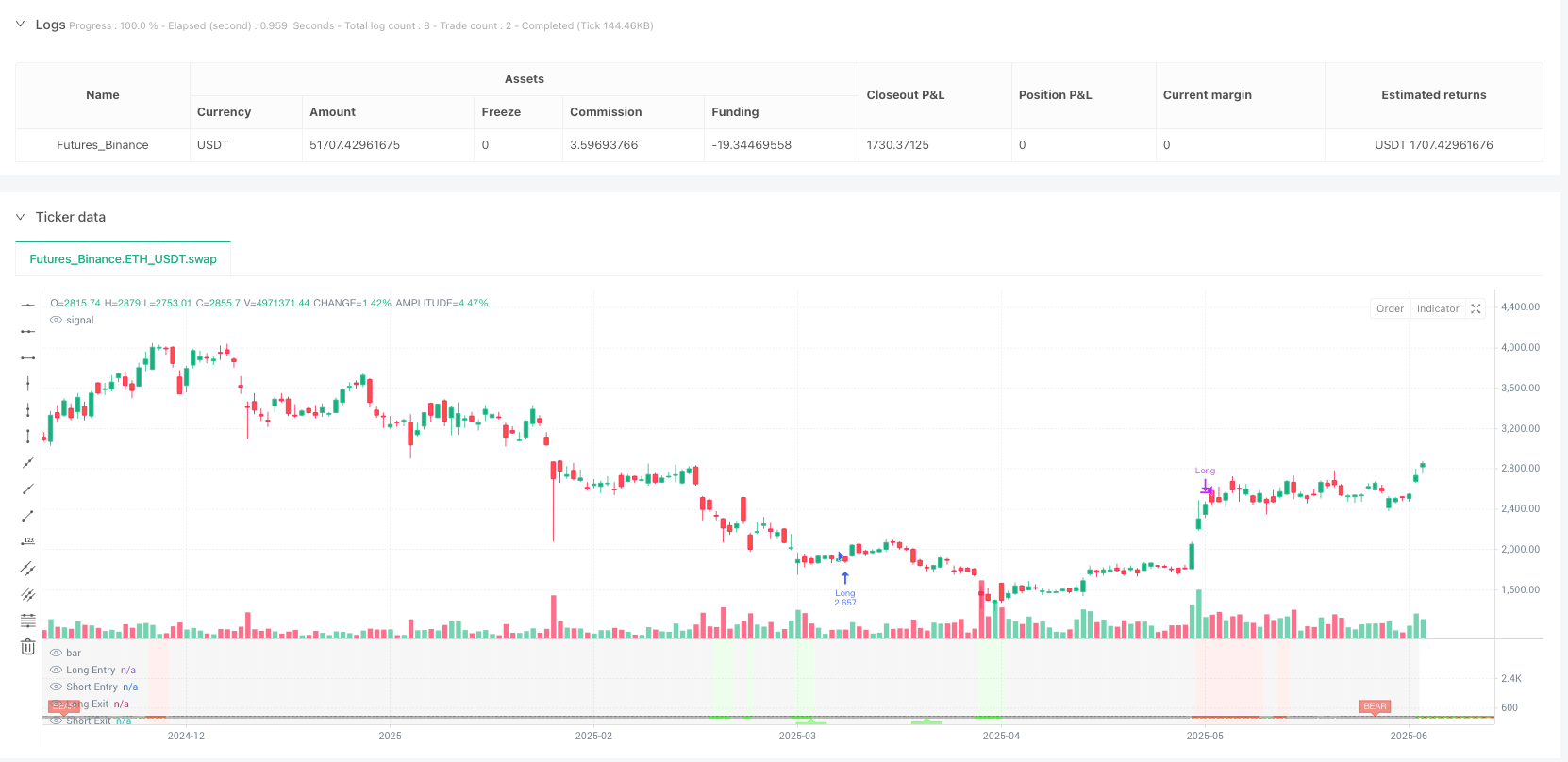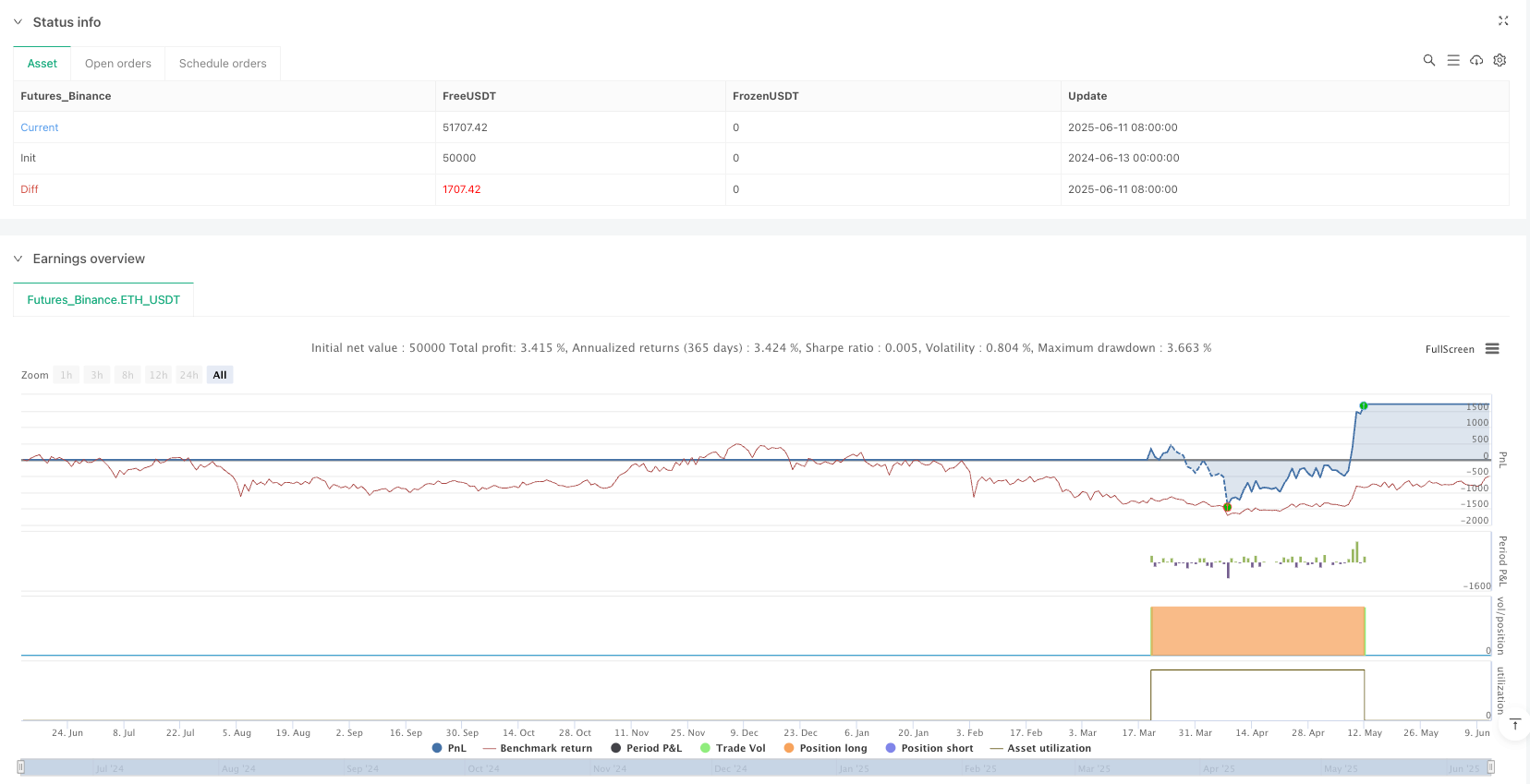

概述
RSI趋势背离策略指标是一种高级量化交易工具,它利用相对强弱指数(RSI)和价格之间形成的背离关系,为交易者提供高概率的买入和卖出信号。该策略特别针对30分钟时间框架进行了优化,通过精确计算的RSI入场和出场水平,结合牛熊背离信号,有效识别市场转折点。该策略允许交易者根据不同市场和时间框架的特性,调整RSI的入场和出场参数,以优化交易结果。
策略原理
RSI趋势背离策略基于两个核心技术指标的协同作用:
相对强弱指数(RSI)过买/过卖水平:策略允许用户自定义RSI的入场和出场水平。默认设置中,多头入场水平为35.0,空头入场水平为76.0,多头出场水平为80.0,空头出场水平为54.1。这些水平是通过多年的经验测试得出的,专为30分钟时间框架优化。
RSI背离信号:策略识别两种类型的背离:
- 牛市背离:当价格创新低但RSI未能跟随创新低时形成,表明下跌动能减弱
- 熊市背离:当价格创新高但RSI未能跟随创新高时形成,表明上涨动能减弱
策略执行逻辑如下: - 当RSI低于多头入场水平(35.0)且同时检测到牛市背离时,触发多头入场信号 - 当RSI高于空头入场水平(76.0)且同时检测到熊市背离时,触发空头入场信号 - 当RSI达到多头出场水平(80.0)时,关闭多头头寸 - 当RSI达到空头出场水平(54.1)时,关闭空头头寸
系统通过回溯5个柱的数据来识别背离,并在满足条件时自动生成交易信号,大幅减少了手动分析的需求。
策略优势
高精度信号过滤:通过结合RSI水平和价格背离,有效过滤掉弱信号,只在高概率转折点触发交易,提高交易成功率。
可定制性强:交易者可以根据不同市场和时间框架的特性,调整RSI的入场和出场水平,优化策略表现。这种灵活性使其适用于各种交易品种和时间周期。
直观的视觉辅助:策略提供了丰富的视觉元素,包括:
- 牛市背离时的绿色”BULL”标签
- 熊市背离时的红色”BEAR”标签
- 背离连接线,直观显示RSI关键点之间的关系
- RSI过买区(红色)、过卖区(绿色)和中性区(灰色)的背景色区分
自动化交易潜力:支持通过TradingView的Webhook功能与外部交易平台集成,实现交易自动化执行,减少人为干预和情绪影响。
开源透明:策略代码完全开源,允许交易者深入了解其工作原理,并根据自身需求进行修改和优化。
策略风险
市场趋势风险:该策略在识别转折点方面表现良好,但在强趋势市场中可能产生错误信号。特别是在强烈下跌趋势或熊市中,多头信号的可靠性会显著降低。
参数敏感性:RSI入场和出场水平的设置对策略表现有重大影响。不适当的参数设置可能导致过多交易或错过重要机会。解决方法是通过回测针对特定市场和时间框架优化参数。
时滞风险:由于策略使用滞后指标(RSI)和需要等待背离形成,可能导致入场点不够理想,尤其在波动剧烈的市场中。
假突破风险:市场可能形成假背离信号,导致错误交易。建议结合其他技术指标或更高时间框架确认信号。
佣金和滑点影响:策略默认设置了0.1%的佣金,但实际交易中的佣金和滑点可能与设定值不同,影响实际回测结果与真实交易表现的差异。
策略优化方向
多时间框架分析整合:将策略扩展为多时间框架分析系统,只在较高时间框架趋势方向与背离信号一致时执行交易。例如,只有当日线图显示上升趋势且30分钟图表出现牛市背离时,才执行多头交易。
增加交易量过滤器:在背离信号形成时增加交易量确认机制,提高信号可靠性。例如,可以检查背离形成时的交易量是否呈现背离或确认模式。
自适应RSI参数:开发自适应算法,根据市场波动性自动调整RSI的入场和出场水平,适应不同市场环境。
止损机制优化:目前策略仅基于RSI水平退出交易,可以增加基于价格的止损机制,限制单笔交易的最大亏损。
增加市场环境过滤:整合趋势识别指标(如移动平均线或ADX),只在适当的市场环境中执行特定方向的交易,避免逆势交易。
机器学习优化:利用机器学习算法分析历史数据,自动识别最佳的RSI参数和背离确认条件,进一步提高策略表现。
总结
RSI趋势背离策略指标是一种功能强大的量化交易工具,通过结合RSI指标和价格背离,有效识别市场转折点。该策略最显著的优势在于其高度可定制性和直观的视觉辅助,使交易者能够根据不同市场环境优化交易决策。
策略的核心价值在于其信号过滤能力,通过仅在RSI处于特定水平且同时出现价格背离时触发交易,大幅提高了交易信号的质量。然而,使用者需要注意市场趋势风险和参数敏感性,并通过回测找到适合特定市场和时间框架的最佳参数。
通过多时间框架分析、交易量确认、自适应参数和增强的风险管理机制等优化方向,该策略有潜力进一步提升其性能和适应性。对于寻求技术指标驱动的量化交易策略的交易者而言,这是一个值得深入研究和应用的工具。
/*backtest
start: 2024-06-13 00:00:00
end: 2025-06-12 00:00:00
period: 1d
basePeriod: 1d
exchanges: [{"eid":"Futures_Binance","currency":"ETH_USDT"}]
*/
//@version=6
strategy(title="RSI Divergence Strategy", shorttitle="RSI Divergence Strategy", overlay=false, default_qty_type=strategy.percent_of_equity, default_qty_value=10, commission_type=strategy.commission.percent, commission_value=0.1, slippage=0, initial_capital=100000, currency=currency.USD, process_orders_on_close=false)
// RSI Settings
rsiLengthInput = input.int(14, minval=1, title="RSI Length", group="RSI Settings")
rsiSourceInput = input.source(close, "Source", group="RSI Settings")
calculateDivergence = input.bool(true, title="Calculate Divergence", group="RSI Settings", tooltip="Required for divergence signals")
// Added RSI Level Inputs
longEntryLevel = input.float(35.0, "Long Entry RSI", minval=0, maxval=100, step=0.1, group="RSI Levels")
shortEntryLevel = input.float(76.0, "Short Entry RSI", minval=0, maxval=100, step=0.1, group="RSI Levels")
longExitLevel = input.float(80.0, "Long Exit RSI", minval=0, maxval=100, step=0.1, group="RSI Levels")
shortExitLevel = input.float(54.1, "Short Exit RSI", minval=0, maxval=100, step=0.1, group="RSI Levels")
// RSI Calculation
change = ta.change(rsiSourceInput)
up = ta.rma(math.max(change, 0), rsiLengthInput)
down = ta.rma(-math.min(change, 0), rsiLengthInput)
rsi = down == 0 ? 100 : up == 0 ? 0 : 100 - (100 / (1 + up / down))
// Divergence Parameters
lookbackRight = 5
lookbackLeft = 5
rangeUpper = 60
rangeLower = 5
_inRange(bool cond) =>
bars = ta.barssince(cond)
rangeLower <= bars and bars <= rangeUpper
var bool plFound = false
var bool phFound = false
var bool bullCond = false
var bool bearCond = false
// Global variables to store _inRange results
var bool inRangePlFound = false
var bool inRangePhFound = false
rsiLBR = rsi[lookbackRight]
// Update _inRange results on every bar
inRangePlFound := _inRange(plFound[1])
inRangePhFound := _inRange(phFound[1])
if calculateDivergence
// Regular Bullish Divergence
plFound := not na(ta.pivotlow(rsi, lookbackLeft, lookbackRight))
rsiHL = rsiLBR > ta.valuewhen(plFound, rsiLBR, 1) and inRangePlFound
lowLBR = low[lookbackRight]
priceLL = lowLBR < ta.valuewhen(plFound, lowLBR, 1)
bullCond := priceLL and rsiHL and plFound
// Regular Bearish Divergence
phFound := not na(ta.pivothigh(rsi, lookbackLeft, lookbackRight))
rsiLH = rsiLBR < ta.valuewhen(phFound, rsiLBR, 1) and inRangePhFound
highLBR = high[lookbackRight]
priceHH = highLBR > ta.valuewhen(phFound, highLBR, 1)
bearCond := priceHH and rsiLH and phFound
// Strategy Entries with customizable RSI levels
if bullCond and rsi < longEntryLevel
strategy.entry("Long", strategy.long)
if bearCond and rsi > shortEntryLevel
strategy.entry("Short", strategy.short)
// Strategy Exits with customizable RSI levels
if rsi >= longExitLevel
strategy.close("Long")
if rsi <= shortExitLevel
strategy.close("Short")
// ———————— Visualizations ———————— //
// Plot RSI line
rsiColor = rsi > 70 ? color.new(#ff5252, 0) : rsi < 30 ? color.new(#4bf335, 0) : color.new(#b8b8b8, 0)
plot(rsi, title="RSI", color=rsiColor, linewidth=2, style=plot.style_line)
// Plot horizontal levels
hline(longEntryLevel, "Long Entry", color=color.new(#4bf335, 0), linestyle=hline.style_solid)
hline(shortEntryLevel, "Short Entry", color=color.new(#ed1404, 0), linestyle=hline.style_solid)
hline(longExitLevel, "Long Exit", color=color.new(#4bf335, 0), linestyle=hline.style_dashed)
hline(shortExitLevel, "Short Exit", color=color.new(#ed1404, 0), linestyle=hline.style_dashed)
// Plot traditional levels
ob = 70
os = 30
hline(ob, "Overbought", color=color.new(#ff5252, 70), linestyle=hline.style_dotted)
hline(os, "Oversold", color=color.new(#4bf335, 70), linestyle=hline.style_dotted)
// Background colors
bgcolor(rsi >= ob ? color.new(#ff5252, 90) : na)
bgcolor(rsi <= os ? color.new(#4bf335, 90) : na)
bgcolor(rsi > os and rsi < ob ? color.new(#424242, 95) : na)
// ———————— DIVERGENCE VISUALS ———————— //
// Position labels below RSI for bullish, above for bearish
bullLabelY = math.max(0, rsi[lookbackRight] - 15) // Position below RSI line
bearLabelY = math.min(100, rsi[lookbackRight] + 15) // Position above RSI line
// CORRECTED: Pass y-coordinate as first argument for absolute positioning
plotshape(bullCond ? bullLabelY : na, title="Bullish Divergence", text="BULL", style=shape.labelup,
location=location.absolute, color=color.new(#4bf335, 50), textcolor=color.white,
size=size.tiny, offset=-lookbackRight)
plotshape(bearCond ? bearLabelY : na, title="Bearish Divergence", text="BEAR", style=shape.labeldown,
location=location.absolute, color=color.new(#ed1404, 50), textcolor=color.white,
size=size.tiny, offset=-lookbackRight)